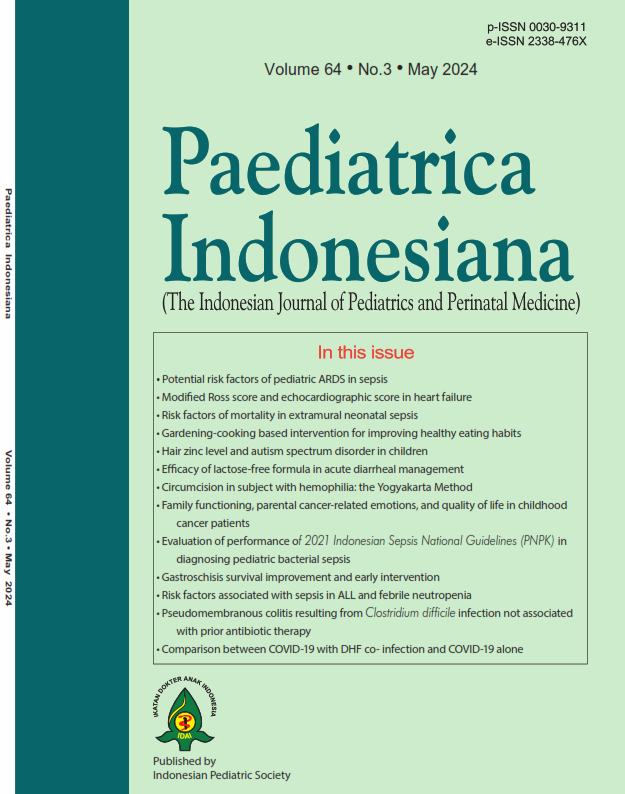Hair zinc level and autism spectrum disorder in children
DOI:
https://doi.org/10.14238/pi64.3.2024.227-32Keywords:
Autism spectrum disorder, children, hair zinc levelAbstract
Background Autism spectrum disorder (ASD) is one of the most common neurodevelopmental disorders. In children with ASD, the neurodevelopmental and behavioral disorders are characterized by impaired quality of interaction, communication, and social imagination, with limited interest and repetitive behavior. Various studies have found that the mean zinc level is lower in children with ASD than in children without ASD, especially in the low functioning autism.
Objective To compare hair zinc level in children with and without ASD.
Methods This case-control study included children with ASD and controls without ASD. Subjects were children under 5 years old who came to Prof I.G.N.G. Ngoerah Hospital and Masadini Clinic in Denpasar. Hair zinc cut-off level was determined by the area under curve (AUC) based on the receiver operating characteristic (ROC) curve.
Results A total of 128 subjects consisted of 64 cases and 64 controls, with a mean age of 4 (SD 0.8) years. Most subjects were male (76%); 82.3% were well-nourished. The mean maternal age at delivery was 28.82 (SD 3.2) years. Subjects’ mean hair zinc level was 87.9 (SD 231.1) ?g/g. Bivariate analysis with Chi-square test revealed that children with hair zinc concentration of <33.88 ?g/g were 22.19 times more likely to have ASD than those with higher zinc levels (OR 22.19; 95%CI 8.02 to 42.09; P<0.001).
Conclusion Low hair zinc level is more likely to occur in children with ASD than in children without ASD.
References
2. Neggers YH. Increasing prevalence, changes in diagnostic criteria and nutritional risk factors for autism spectrum disorders. ISRN Nutr. 2014:514026. DOI: https://doi.org/10.1155/2014/514026
3. Bjorklund G. The role of zinc and copper in autism spectrum disorders. Acta Neurobiol Exp. 2013;73:225–36. DOI: https://doi.org/ 10.55782/ane-2013-
4. Nair KM, Choudhury DR. Zinc nutrition in health and diseases. J of SAT Sat Agric Res. 2013;11:1-6.
5. Priya MDL, Geetha A. Level of trace elements (copper, zinc, magnesium and selenium) and toxic elements (lead and mercury) in the hair and nail of children with autism. Biol Trace Elem Res. 2011;142:148–58. DOI: https://doi.org10.1007/s12011-010-8766-2
6. Yorbik O, Akay C, Sayal A, Cansever A, Sohmen T, Çavdar AO. Zinc status in autistic children. J Trace Elem Exp Med. 2004;17:101–7. DOI: https://doi.org/10.1002/jtra.20002
7. Blauroch-Busch E, Amin OR, Dessoki HH, Rabah T. Toxic metals and essential elements in hair and severity of symptoms among children with autism. Maedica (Bucur) . 2012;7:38-48. PMID: 23118818.
8. Al-Farsi YM, Waly MI, Al-Sharbati M, Al Shafaee MA, Al-Farsi OA, Al-Khaduri MM, et al. Levels of heavy metals and essential minerals in hair samples of children with autism in Oman: a case-control study. Biol Trace Elem Res. 2012;151:193-209. DOI: https://doi.org/10.1007/s12011-012-9553-z
9. Wessells KR, Brown KH, Arnold CD, Barffour MA, Hinnouho G-M, Killilea DW, Kounnavong S, Hess SY. Plasma and nail zinc concentrations, but not hair zinc, respond positively to two different forms of preventive zinc supplementation in young Laotian children: a randomized controlled trial. Biol Trace Elem Res. 2021;199:442-52. DOI: https://doi.org/10.1007%2Fs12011-020-02163-2
10. American Psychiatric Association. The Diagnostic and Statistical Manual of Mental Disorder, 5th Edition (DSM-V). United States. 2006.
11. Celik B, Nalcacioglu H, Karakukcu C, Aslaner H. Assessment of hair zinc in the school children in Kayseri, Turkey. Biol Trance Elem Res. 2020; 196(4):1-6. DOI: 10.1007/s12011-020-02115-w
12. Ferreira HS. Anthropometric assessment of children’s nutritional status: a new approach based on an adaptation of Waterlow’s classification. BMC Ped. 2020; 20(65). DOI: https://doi.org/10.1186/s12887-020-1940-6
13. Widiyanti D, Kusmita D. Pengaruh riwayat genetik dan jenis kelamin dengan kejadian autis. J Kebidanan Besurek. 2016;1:82-8.
14. Dworzynski K, Ronald A, Bolton P, Happe F. How different are girls and boys above and below the diagnostic threshold for autism spectrum disorders?. J Am Acad Child Adolesc Psychiatry. 2012;51:788-97. DOI: https://doi.org/10.1016/j.jaac.2012.05.018
15. Liu X, Liu J, Xiong X, Yang X, Hou N, Liang X, et al. Correlation between nutrition and symptoms: nutritional survey of children with autism spectrum disorder in Chongqing, China. Nutrients. 2016;8:294-309. DOI: https://doi.org/10.3390/nu8050294
16. Wijayanti AP, Mutalazimah M. Hubungan asupan energi dengan status gizi anak autis di yayasan pembinaan anak cacat (YPAC) kota Surakarta. J Kesehatan. 2018;11:9-15. DOI: https://doi.org/10.23917/jk.v11i1.6999
17. Yousef AM, Roshdy EH, Fattah NRA, Said RM, Atia MM, Hafez EM, et al. Prevalence and risk factors of autism spectrum disorders in preschool children in Sharkia, Egypt: a community-based study. Middle East Current Psychiatry. 2021;28:36. DOI: https://doi.org/10.1186/s43045-021-00114-8
18. Choi DW, Weiss JH, Koh JY, Christine CW, Kurth MC. Glutamate neurotoxicity, calcium and zinc. Ann N Y Acad Sci. 2006; 568: 219-24. DOI: https://doi.org/10.1111/j.1749-6632.1989.tb12511.x
19. Faber S, Zinn GM, Kern JC, Kingston HMS. The plasma zinc/serum copper ratio as a biomarker in children with autism spectrum disorders. Biomarkers. 2009;14:171–80. DOI: https://doi.org/10.1080/13547500902783747
20. Goyal DK, Neil JR, Simmons SD, Mansab F, Benjamin S, Pitfield V, et al. Zinc deficiency in autism: a controlled study. Insights Biomed. 2019;4:12. DOI: https://doi.org/10.36648/2572-5610.4.3.63
21. Babaknejad N, Sayehmiri F, Sayehmiri K, Mohamadkhani A, Bahrami S. The relationship between zinc levels and autism: a systematic review and meta-analysis. Iran J Child Neurol. 2016;10:1-9. PMID: 27843460.
22. Alsufiani HM, Alkhanbashi AS, Laswad NAB, Bakhadher KK, Alghamdi SA, Tayeb HO, et al. Zinc deficiency and supplementation in autism spectrum disorder and Phelan-McDermid syndrome. J Neurosci Res. 2022;100:970-8. DOI: https://doi.org/10.1002/jnr.25019
Downloads
Published
How to Cite
Issue
Section
License
Authors who publish with this journal agree to the following terms:
Authors retain copyright and grant the journal right of first publication with the work simultaneously licensed under a Creative Commons Attribution License that allows others to share the work with an acknowledgement of the work's authorship and initial publication in this journal.
Authors are able to enter into separate, additional contractual arrangements for the non-exclusive distribution of the journal's published version of the work (e.g., post it to an institutional repository or publish it in a book), with an acknowledgement of its initial publication in this journal.
Accepted 2024-05-28
Published 2024-05-28














